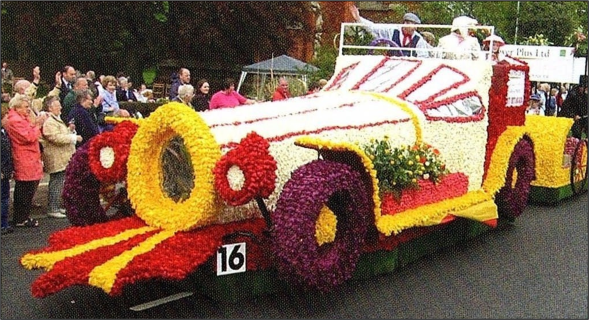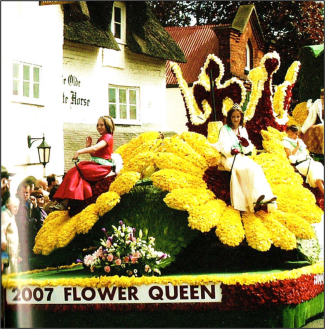The Dragon Stopped Breathing
This article appeared in our March 2023 Newsletter
Mid Morning – and a quietness starts to settle on the town, like the hush you get after a fall of snow. The central roads are being closed down and the under-growl of traffic fades into silence. The town is holding its breath – until, faintly in the distance, the sound of a band begins. One o’clock. The Tulip Parade is under way.
Originally, the Parade started from the Halley Stewart Field and finished there. By 2010 it had for some years begun and ended at Springfields. The route ran along Queen’s Road, Halmer Gate and Love Lane, turned right along the river to the tricky crossing of High Bridge, then through the town centre to Pinchbeck Road and West Elloe Avenue to return to Springfields.
The procession was headed by a troop of mounted police, then came the 20 or so large floats and several smaller ones, with about 10 marching bands at intervals. The large floats were sponsored by local firms such as Geo.Adams, Lingarden and Geest’s and nationals such as the East Midlands Electricity Board, British Rail, and the Halifax Building Society. Each has its crew, costumed and cushioned amongst the banks of tulip heads or walking alongside. The smaller floats are the work of local clubs and organisations: the Gleed School, churches, the Young Farmers and a village or two. It takes about two- and-a-half hours to get round.
The marshalling of the vast and varied assemblage, over 700 in all, is little short of a miracle. One o’clock approaches. A late child is lifted onto a float. The Parade starts. On time. Then stops. A float is discovered to have two flat tyres. The Parade’s breakdown vehicle is called up – everything has been thought of – and two men disappear under the float’s skirting. Reinflated, the procession gets under way again.
Queen’s Road, Halmer Gate …… It’s roasting hot. Everyone has a bottle of water. When emptied, there are some walking the route with large bottles, three or four to a bag, to refill the empties. A young tiger on the Jungle Books float takes his head off and wipes a paw across a streaming face. Toilets? Oh dear, yes. toilets. “Miss, I can’t wait.” People living along the route are kind and understanding, and will let a desperate little Goldilocks or Grumpy or Sneezy use the toilet in their house. Relieved, Goldilocks runs to catch up with her Three Bears. Love Lane, the river and the councillors’ grandstand ……
Another pause. Another flat tyre. This time at High Bridge. And that’s where the dragon stops breathing as well. A quick bit of adjustment to the smoke machine somewhere
in the flowers. And then the dragon is on his way again up Bridge Street and through the Market Place, nostrils puffing contentedly each time the button is pressed.
The floats had begun life months before, their skeletons hammered and welded into shape one by one by Geoff Dodd at the Chain Bridge Forge, and then fleshed out with layers of polystyrene glued together. With them eventually all gathered in a large auction shed on Winfrey Avenue, it is a race against time now. Cropped a few days before, the tulip heads have been brought in from all over the district, sorted by colour into the sort of huge canvas bags you find in builders’ yards – red, purple, pink, yellow, white …… Then, with two or three days to go, the pinning begins, a thousand heads per square yard.
It is all entirely voluntary. Workers from a sponsoring firm work on their float, drawing in family members, neighbours, friends, friends of friends, mates from school, all recruited by word of mouth in these pre-Facebook days. Most come along after tea. There is no reward, not even a special viewing space reserved for those who’ve pinned their fingers almost red-raw. It’s partly competitive, of course, but there is a great feeling of community spirit. It was felt to be more an honour like to be part of it, an event famous throughout the country and beyond.
And flock from far and near people did, 100,000 or more when the parade was at its height, some year after year, like the London Underground driver and his wife we chatted to. British Rail laid on special trains. The Grammar School’s West Field was crammed edge to edge with coaches. Caravans, campervans and tents filled its Memorial Field. And it was the same at the Gleed. Pop-up carparks popped up on brownfield sites. The Gleed School opened up its kitchen and canteen to serve breakfasts for those on its fields who’d stayed overnight. The Rugby Club did the same for the campers and camper-vanners on the Memorial Field.
It was not only spectators who flocked in either, but stall-traders from all over as well. By 8.30 any space too small to park a car had its array, most noticeably between the bus station and the town centre: giant teddies and pandas, potted plants, cheap shoes, baseball hats, trumpets and trinkets, the latest playground craze, hot dogs, plastic toys, mugs with the Lincoln Imp and tea-towels with the Cathedral, fizzy drinks, parasols or umbrellas according to the forecast, sparkly things, T-shirts with slogans, balloons, and little folding canvas stools – it’s a long time to stand.
It is a glorious fund-raising opportunity for churches and charities, too. Circulating amongst the crowds and along the route, conspicuous in their clown’s get-up, South Holland Rotary regularly collect £10,000 in their collecting buckets, to be shared half to the Parade organisation and half to the charities Rotary supports. The charity stalls tend to cabbages and cauliflowers, onions and rhubarb, fresh from allotments and back gardens and home-made cakes and marmalade, and, particularly welcome as the afternoon wears on, a cup of tea and a sit-down in the church hall.
With up to 100,000 visitors in the town centre and along the route, public order and security are an obvious concern and neighbouring police forces have been called on for support. Their surveillance vehicles have TV cameras on tall masts at two or three particularly crowded spots – across from the Lincolnshire Poacher, for example – but there‘s rarely any serious trouble. Some drunkenness and shop-lifting inevitably – so that some shops think it wiser to stay closed on parade day – and lost children to be restored to their parents.
With the parade over, the trains and coaches and cars and the crowds begin to depart, with their balloons and souvenir programmes and rhubarb, leaving a floating layer of drinks cans and plastic ‘glasses’ at High Bridge and a town that feels oddly empty now as evening settles in. Not silent, though. There’s laughter from the pubs and music from the Radio One disco in the South Holland Centre. On the darkening school fields the tents are scattered baubles of light. And on a hundred kitchen and committee room tables the good-cause takings are being counted.
Visitors who like things a bit quieter would come into Spalding on the Sunday to view the floats set out in the Springfields arena and, as they drive home, stop perhaps at one of the village churches to marvel at the imaginative displays in the flower-filled interiors, and take back with them a little something of South Holland, home-grown or home-made.
Recollections of Andrew and Marianne Upton. (as told to our Newsletter Editor)
Marianne was one of those who walked the route with the refuelling bottles of water in 2010 and it was Andrew who got the dragon breathing again. The dragon float is one of the few surviving from past parades and will be part of the show again this year – with smoke!


